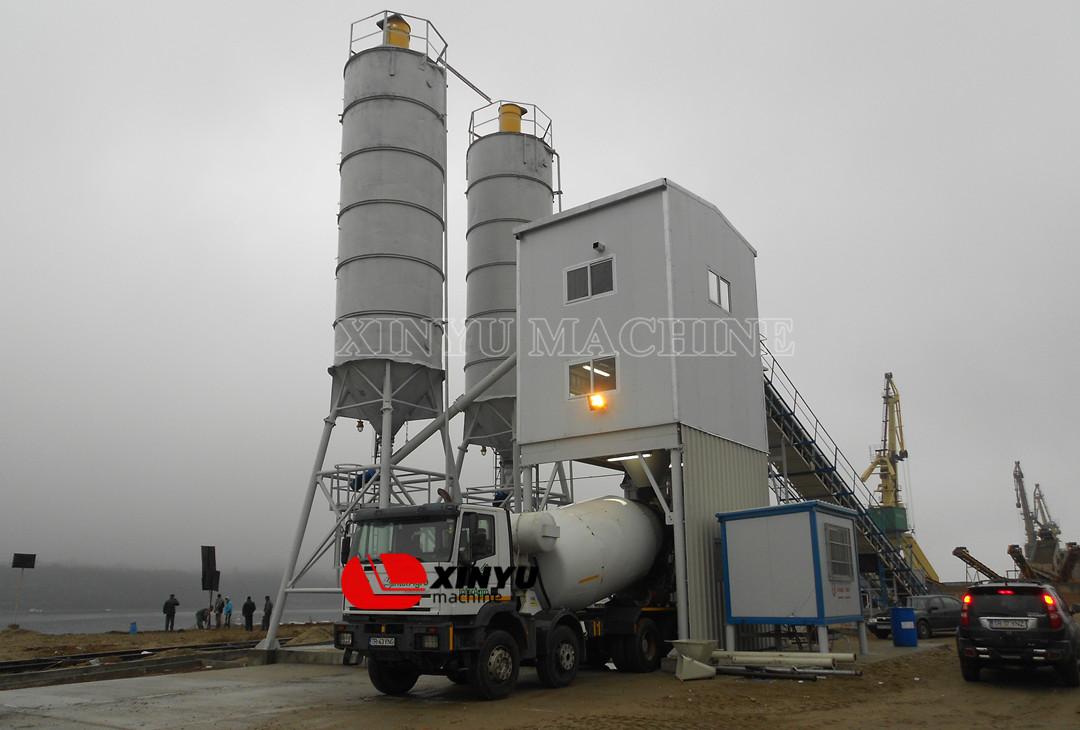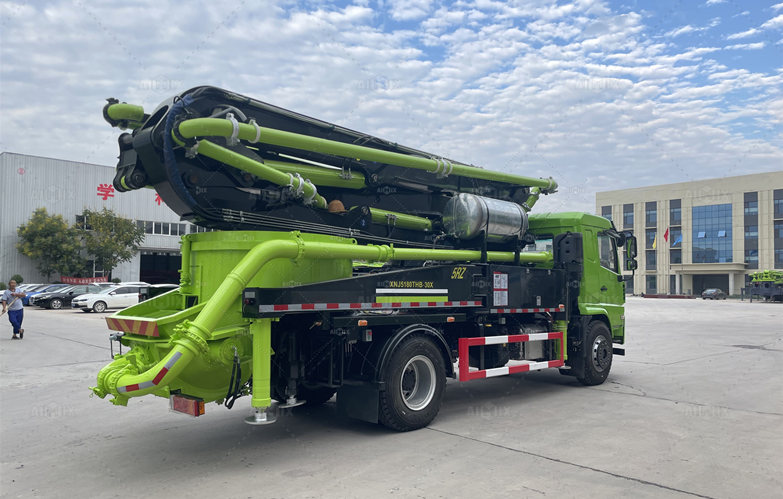Successful Application Case of Concrete Batching Plant in Armenia's Infrastructure Development Projects
Aug 15, 2025
As a landlocked country in the South Caucasus, Armenia has been actively advancing infrastructure construction in recent years to boost economic growth and improve people's livelihoods. With the government's emphasis on transportation networks, urban renewal, and industrial parks, the demand for high-quality concrete has surged across various projects, including highway expansions, residential building complexes, and hydropower facilities. In this context, efficient and reliable concrete batching plants have become a cornerstone of Armenia's construction sector. Our concrete batching plant solutions have delivered outstanding performance in supporting the country's infrastructure development.
Analysis of Concrete Batching Plant
Our concrete batching plants are engineered with advanced technology and high-grade components, including wear-resistant mixing blades, precision weighing systems, and intelligent control panels. The core structure adopts a modular design, combining a concrete mixer, aggregate batching machine, cement silo, and conveyor belt into an integrated system. This ensures stable operation even in Armenia's diverse climatic conditions—from the hot summers in Yerevan to the cold winters in mountainous regions.
Concrete batching plants boast several key features and advantages:
•High Production Efficiency: Equipped with dual-shaft forced mixers, our plants can produce 50 to 200 cubic meters of concrete per hour, meeting the large-volume demands of Armenia's large-scale projects. For example, in a highway construction project connecting Yerevan and Gyumri, the plant maintained continuous production for 12 hours daily, ensuring timely concrete supply.
•Precise Mixing Quality: Advanced electronic weighing systems control the ratio of cement, aggregates, water, and additives with an error margin of less than 1%, guaranteeing uniform concrete quality. This precision is critical for projects like Armenia's earthquake-resistant building initiatives, where structural strength is paramount.
•Energy Efficiency and Environmental Friendliness: The plants are designed with low-noise motors and dust-collecting devices, reducing noise pollution and dust emissions. This aligns with Armenia's environmental protection regulations, especially in urban areas like Yerevan where construction must minimize impact on residents.
•Flexible Configuration: Plants can be customized based on project scale and site conditions. Mobile batching plants are ideal for remote areas such as rural road construction, while stationary plants with large storage silos suit long-term projects like industrial park development in Lori Province.
•Easy Operation and Maintenance: The intelligent control system features a user-friendly touchscreen interface, allowing operators to monitor production in real time and adjust parameters effortlessly. Routine maintenance is simplified with accessible components, reducing downtime—vital for meeting tight project deadlines in Armenia.
Specifications and Customization Options
Our concrete batching plants offer diverse specifications to cater to Armenia's varied construction needs:
•Small-scale plants (50-80 m³/h) are suitable for village road repairs and small residential projects.
•Medium-scale plants (100-150 m³/h) serve urban expansion projects, such as apartment complex construction in Vanadzor.
•Large-scale plants (180-200 m³/h) are designed for major infrastructure like the North-South Highway renovation, ensuring high-volume concrete supply.
Beyond standard models, we provide tailored solutions. For instance, in a hydropower project in the Aras River basin, we customized a plant with frost-resistant components to withstand subzero temperatures and added a special admixture system to enhance concrete's water resistance.
Background Analysis of Armenia's Construction Needs
Armenia's infrastructure development has accelerated in recent years, driven by government investments and international aid. Key priorities include upgrading transportation networks to boost trade, constructing earthquake-resistant housing to address safety concerns, and building industrial zones to attract foreign investment. According to the Armenian Ministry of Territorial Administration and Infrastructure, concrete demand in 2024 increased by 18% compared to the previous year, with a growing focus on quality, efficiency, and sustainability.
Challenges in Armenia's construction sector include fluctuating material supply (e.g., aggregates from local quarries) and harsh weather conditions, which demand robust and adaptable equipment. Our concrete batching plants were designed to address these challenges, ensuring consistent performance across diverse scenarios.
Customer Core Requirements
The Armenian customer, a leading construction company overseeing multiple infrastructure projects, had three primary requirements for the concrete batching plant:
1.Reliability in Extreme Conditions: The plant must operate stably in both high temperatures (up to 40°C in summer) and cold winters (as low as -15°C), with minimal breakdowns.
2.Cost-Effectiveness: The solution needed to balance high production capacity with energy efficiency to reduce long-term operational costs, critical for budget-constrained public projects.
3.Quick Deployment: Given tight project timelines, the plant required easy installation and commissioning to start production within 2 weeks of delivery.
Application in Yerevan Urban Renewal Project
A notable application is the urban renewal project in Yerevan's Ajapnyak district, where the customer aimed to rebuild 50 aging apartment buildings into earthquake-resistant structures. Our team conducted on-site assessments, analyzing local material availability (e.g., sand from Lake Sevan quarries) and climate patterns to recommend a medium-scale stationary batching plant with customized features:
•A frost-resistant mixer jacket to prevent concrete freezing in winter.
•An automated aggregate storage system to handle fluctuating supply from local vendors.
•A dust collection unit to comply with Yerevan's strict air quality standards.
During installation, our engineers collaborated with the customer's team to complete setup in 10 days, followed by 3 days of training for operators. The plant produced over 1,200 cubic meters of concrete weekly, maintaining a 98% operational rate throughout the 8-month project. The concrete met Armenia's GOST 7473-2010 standards for compressive strength (≥30 MPa), ensuring structural safety.
Customer Feedback and Project Achievements
Post-project, the customer expressed high satisfaction with the concrete batching plant's performance:
•Stability: The plant operated without major breakdowns, even during winter storms, ensuring uninterrupted concrete supply.
•Cost Savings: Energy-efficient motors reduced electricity consumption by 12% compared to their previous equipment, saving approximately 15 million AMD (≈30,000 USD) over the project duration.
•Efficiency: The quick deployment and high production capacity shortened the construction period by 1 month, allowing residents to move into new homes ahead of schedule.
This success has positioned our concrete batching plants as a trusted choice for Armenia's infrastructure sector. Moving forward, we will continue to optimize our solutions, focusing on keywords like "concrete batching plant Armenia," "sustainable construction equipment," and "earthquake-resistant concrete production," to support the country's growing development needs.
📩Email: sale@zgxinyu.com
🌐
https://www.xinyumachine.com/
☎ DM: 008613526645418 (WhatsApp / Wechat / Viber / Telegram)
#constructionmachinery #constructionequipment #ConstructionSupplies
#concretebatchingplant #batchingplant #concretemixingplant #mobileconcretebatchingplant #RoadConstructionEquipment #AsphaltMixingPlant Successful Application Case of Concrete Batching Plant in Armenia's Infrastructure Development Projects
Aug 15, 2025
As a landlocked country in the South Caucasus, Armenia has been actively advancing infrastructure construction in recent years to boost economic growth and improve people's livelihoods. With the government's emphasis on transportation networks, urban renewal, and industrial parks, the demand for high-quality concrete has surged across various projects, including highway expansions, residential building complexes, and hydropower facilities. In this context, efficient and reliable concrete batching plants have become a cornerstone of Armenia's construction sector. Our concrete batching plant solutions have delivered outstanding performance in supporting the country's infrastructure development.
Analysis of Concrete Batching Plant
Our concrete batching plants are engineered with advanced technology and high-grade components, including wear-resistant mixing blades, precision weighing systems, and intelligent control panels. The core structure adopts a modular design, combining a concrete mixer, aggregate batching machine, cement silo, and conveyor belt into an integrated system. This ensures stable operation even in Armenia's diverse climatic conditions—from the hot summers in Yerevan to the cold winters in mountainous regions.
Concrete batching plants boast several key features and advantages:
•High Production Efficiency: Equipped with dual-shaft forced mixers, our plants can produce 50 to 200 cubic meters of concrete per hour, meeting the large-volume demands of Armenia's large-scale projects. For example, in a highway construction project connecting Yerevan and Gyumri, the plant maintained continuous production for 12 hours daily, ensuring timely concrete supply.
•Precise Mixing Quality: Advanced electronic weighing systems control the ratio of cement, aggregates, water, and additives with an error margin of less than 1%, guaranteeing uniform concrete quality. This precision is critical for projects like Armenia's earthquake-resistant building initiatives, where structural strength is paramount.
•Energy Efficiency and Environmental Friendliness: The plants are designed with low-noise motors and dust-collecting devices, reducing noise pollution and dust emissions. This aligns with Armenia's environmental protection regulations, especially in urban areas like Yerevan where construction must minimize impact on residents.
•Flexible Configuration: Plants can be customized based on project scale and site conditions. Mobile batching plants are ideal for remote areas such as rural road construction, while stationary plants with large storage silos suit long-term projects like industrial park development in Lori Province.
•Easy Operation and Maintenance: The intelligent control system features a user-friendly touchscreen interface, allowing operators to monitor production in real time and adjust parameters effortlessly. Routine maintenance is simplified with accessible components, reducing downtime—vital for meeting tight project deadlines in Armenia.
Specifications and Customization Options
Our concrete batching plants offer diverse specifications to cater to Armenia's varied construction needs:
•Small-scale plants (50-80 m³/h) are suitable for village road repairs and small residential projects.
•Medium-scale plants (100-150 m³/h) serve urban expansion projects, such as apartment complex construction in Vanadzor.
•Large-scale plants (180-200 m³/h) are designed for major infrastructure like the North-South Highway renovation, ensuring high-volume concrete supply.
Beyond standard models, we provide tailored solutions. For instance, in a hydropower project in the Aras River basin, we customized a plant with frost-resistant components to withstand subzero temperatures and added a special admixture system to enhance concrete's water resistance.
Background Analysis of Armenia's Construction Needs
Armenia's infrastructure development has accelerated in recent years, driven by government investments and international aid. Key priorities include upgrading transportation networks to boost trade, constructing earthquake-resistant housing to address safety concerns, and building industrial zones to attract foreign investment. According to the Armenian Ministry of Territorial Administration and Infrastructure, concrete demand in 2024 increased by 18% compared to the previous year, with a growing focus on quality, efficiency, and sustainability.
Challenges in Armenia's construction sector include fluctuating material supply (e.g., aggregates from local quarries) and harsh weather conditions, which demand robust and adaptable equipment. Our concrete batching plants were designed to address these challenges, ensuring consistent performance across diverse scenarios.
Customer Core Requirements
The Armenian customer, a leading construction company overseeing multiple infrastructure projects, had three primary requirements for the concrete batching plant:
1.Reliability in Extreme Conditions: The plant must operate stably in both high temperatures (up to 40°C in summer) and cold winters (as low as -15°C), with minimal breakdowns.
2.Cost-Effectiveness: The solution needed to balance high production capacity with energy efficiency to reduce long-term operational costs, critical for budget-constrained public projects.
3.Quick Deployment: Given tight project timelines, the plant required easy installation and commissioning to start production within 2 weeks of delivery.
Application in Yerevan Urban Renewal Project
A notable application is the urban renewal project in Yerevan's Ajapnyak district, where the customer aimed to rebuild 50 aging apartment buildings into earthquake-resistant structures. Our team conducted on-site assessments, analyzing local material availability (e.g., sand from Lake Sevan quarries) and climate patterns to recommend a medium-scale stationary batching plant with customized features:
•A frost-resistant mixer jacket to prevent concrete freezing in winter.
•An automated aggregate storage system to handle fluctuating supply from local vendors.
•A dust collection unit to comply with Yerevan's strict air quality standards.
During installation, our engineers collaborated with the customer's team to complete setup in 10 days, followed by 3 days of training for operators. The plant produced over 1,200 cubic meters of concrete weekly, maintaining a 98% operational rate throughout the 8-month project. The concrete met Armenia's GOST 7473-2010 standards for compressive strength (≥30 MPa), ensuring structural safety.
Customer Feedback and Project Achievements
Post-project, the customer expressed high satisfaction with the concrete batching plant's performance:
•Stability: The plant operated without major breakdowns, even during winter storms, ensuring uninterrupted concrete supply.
•Cost Savings: Energy-efficient motors reduced electricity consumption by 12% compared to their previous equipment, saving approximately 15 million AMD (≈30,000 USD) over the project duration.
•Efficiency: The quick deployment and high production capacity shortened the construction period by 1 month, allowing residents to move into new homes ahead of schedule.
This success has positioned our concrete batching plants as a trusted choice for Armenia's infrastructure sector. Moving forward, we will continue to optimize our solutions, focusing on keywords like "concrete batching plant Armenia," "sustainable construction equipment," and "earthquake-resistant concrete production," to support the country's growing development needs.
📩Email: sale@zgxinyu.com
🌐 https://www.xinyumachine.com/
☎ DM: 008613526645418 (WhatsApp / Wechat / Viber / Telegram)
#constructionmachinery #constructionequipment #ConstructionSupplies
#concretebatchingplant #batchingplant #concretemixingplant #mobileconcretebatchingplant #RoadConstructionEquipment #AsphaltMixingPlant







